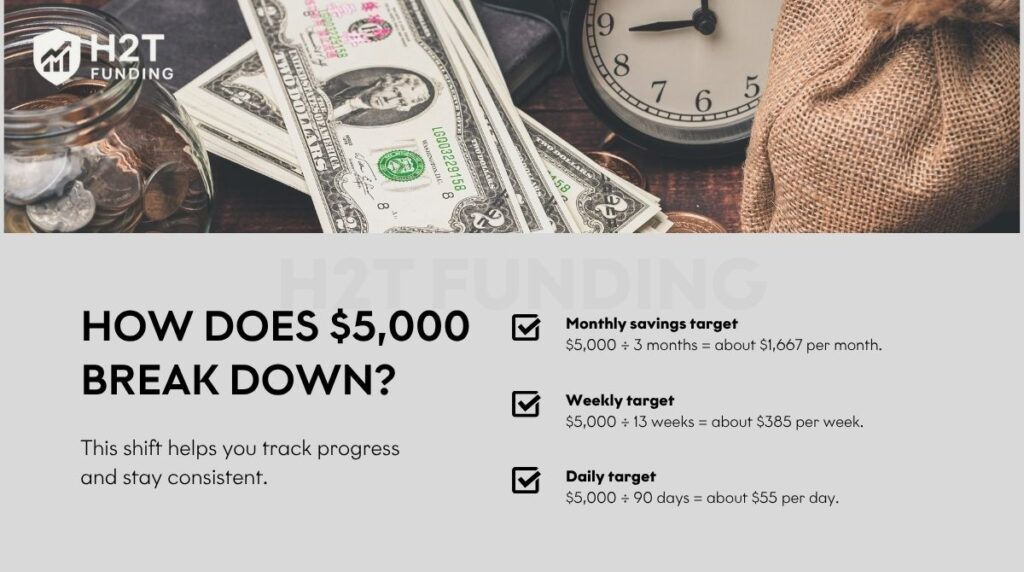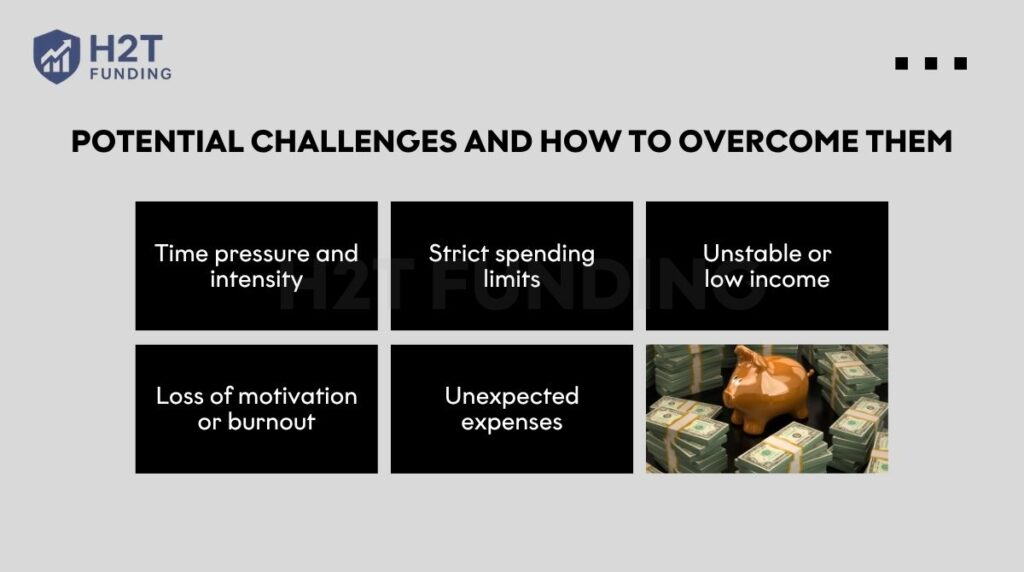Are you planning a big trip, moving out on your own, or paying off a debt soon? Setting a goal like saving $5,000 in just 90 days might sound intimidating at first. But let’s be real, with the right plan and discipline, you can make it happen without feeling overwhelmed.
This guide shows you exactly how to save 5000 in 3 months by breaking down the numbers, cutting unnecessary expenses, and boosting your income where possible. You’ll also learn how to stay motivated and avoid common pitfalls along the way.
By the end, you’ll have a clear, step-by-step strategy that proves even a short-term challenge like this can strengthen your long-term financial habits.
Key takeaways
- Saving $5,000 in 3 months is possible if you put aside about $1,667 each month or $55 a day, with smart budgeting and extra income.
- Breaking the goal into monthly, weekly, daily, or biweekly targets makes progress easier to track and less overwhelming.
- Success depends on combining strategies: cut non-essential expenses, increase income, automate transfers, and use visual tracking to stay motivated.
1. Is it possible to save $5,000 in 3 months?
Yes, it is possible, but it requires focus and commitment. To hit this goal, you’ll need to save about $1,667 each month, or roughly $55 per day. At first glance, these numbers can seem overwhelming, but breaking them down makes the challenge more manageable.

For someone earning between $3,000 and $5,000 a month, reaching this target is realistic if you cut back on non-essential spending and make smarter financial decisions. It’s not easy, but think of it as a 90-day financial bootcamp. The goal is to be aggressive for a short period.
Think of it as a short, intense sprint rather than a lifelong commitment. It can be a strong motivator, pushing you to explore new income opportunities, avoid impulse buying, and learn how to stop living paycheck to paycheck.
2. Goal analysis: How does $5,000 break down?
The fastest way to make a big savings goal feel manageable is to break it into smaller chunks. Instead of focusing on $5,000 as one large figure, think in terms of months, weeks, and even days. This shift helps you track progress and stay consistent.

- Monthly savings target: $5,000 ÷ 3 months = about $1,667 per month.
- Weekly target: $5,000 ÷ 13 weeks = about $385 per week.
- Daily target: $5,000 ÷ 90 days = about $55 per day.
Another effective way is to follow a bi-weekly savings plan. By setting aside $833 every two weeks, you’ll reach the $5,000 goal within 13 weeks without feeling too much pressure at once.
| Bi-weekly period | Amount to save | Total savings |
|---|---|---|
| 1 | $833.33 | $833.33 |
| 2 | $833.33 | $1,666.66 |
| 3 | $833.33 | $2,500.00 |
| 4 | $833.33 | $3,333.33 |
| 5 | $833.33 | $4,166.66 |
| 6 | $833.33 | $5,000.00 |
Once you see the numbers this way, the path becomes clearer. Start by calculating your monthly take-home income. Subtract essential costs like rent, food, and utilities to see how much room you have left.
To make this process easier, you can use simple methods to track expenses and identify where adjustments are possible. If there’s a gap between what you can save and the $1,667 monthly goal, you’ll know exactly how much needs to come from expense cuts or extra income.
View more:
3. How to save 5000 in 3 months
This isn’t about getting lucky; it’s about having a solid plan. Saving $5,000 in three months comes down to three key factors: smart planning, disciplined spending, and finding creative ways to generate extra income. If you’ve been searching for how to save 5k in 3 months, here’s a step-by-step approach you can actually follow.

3.1. Calculate your baseline: Income vs. Expenses
Begin with a clear picture of your finances. List all income sources: salary, freelance, side gigs. Then record every expense, from rent and bills to coffee runs. This simple snapshot shows how much you can realistically save each month.
- Fixed costs: rent, utilities, insurance
- Variable costs: groceries, transport, dining, entertainment
- Extras: subscriptions, shopping, hobbies
Using a budgeting app or a Google Sheet can make this process more accurate and easier to track.
3.2. Set a 3-month savings goal and break it down
Breaking the target into smaller numbers keeps the challenge less overwhelming. Instead of saving evenly, you can increase gradually:
| Month | Target savings | Notes |
|---|---|---|
| 1 | $1,500 | Start strong, set momentum |
| 2 | $1,700 | Adjust spending, boost side gigs |
| 3 | $1,800 | Push harder to reach the goal |
Weekly check-ins help you adjust quickly if you fall behind. I found that setting reminders on my phone made me more consistent, like treating savings as an appointment I couldn’t skip.
3.3. Cut expenses drastically for 90 days
Think of this period as a financial bootcamp. Every dollar you don’t spend moves you closer to the goal. Focus on short-term sacrifices:
- Cook all meals at home.
- Cancel streaming, gym, or app subscriptions. You can also negotiate bills.
- Pause travel, cafes, and eating out to reduce expenses.
- Follow the 30-day rule before buying anything.
- Use public transport or walk whenever possible.
These cuts may feel restrictive, but they free up hundreds each month. Don’t forget to use discounts and coupons whenever possible.
3.4. Boost your income fast
If your paycheck doesn’t cover $1,667 per month, extra income is non-negotiable. Consider:
- Freelance gigs (Upwork, Fiverr, tutoring)
- Part-time shifts on weekends
- Delivery, rideshare, or odd jobs
- Selling unused clothes, furniture, or electronics. A quick declutter can help you sell items for extra cash.
Even adding $500–$1,000 monthly can close the gap. I had to do this myself. I sold an old gaming console that was collecting dust and picked up weekend food delivery shifts. That extra cash was the game-changer.
3.5. Automate and lock away your savings
The best trick is to pay yourself first. Set up an auto-transfer right after payday. Once the money is moved, pretend it doesn’t exist. If possible, choose a restricted account or a high-yield savings account. This way, you’re not tempted to withdraw early.
3.6. Stay motivated with visual tracking
Trust me, your motivation will dip around week six. To fight this, I went low-tech: I drew a simple thermometer on a piece of paper and stuck it on my fridge. Every time I transferred money, I colored it in. Seeing that red line climb up was surprisingly effective and kept my goal front and center every single day.
Reaching this kind of goal isn’t about doing everything perfectly; it’s about staying consistent with the habits that matter most. Small daily choices add up quickly, and three months of focused effort can be enough to completely change your financial momentum.
4. What to do after saving $5,000
Hitting the $5,000 mark in just three months is a huge accomplishment, but what you do next is just as important. Resist the urge to spend it all at once; instead, give your money a clear purpose so it continues to work for you.
A simple approach is to split your savings into buckets: 50% for your immediate goal, such as a trip or a down payment; 30% for investments that can grow over time; and 20% as an emergency cushion. This balance lets you enjoy the reward while still building financial security.

Once the first milestone is achieved, set your sights higher. A natural next challenge could be $10,000 in six months, using the same strategies but with more confidence and discipline. What started as a short sprint can now evolve into a long-term habit.
The real value lies in the mindset you’ve built. By proving to yourself that you can save aggressively, you’ve created a foundation for sustainable saving and investing habits that will keep paying off long after this challenge ends.
5. Potential challenges and how to overcome them
Look, any intense savings challenge is going to have obstacles. The best way to keep from getting derailed is to anticipate them before they happen. Here are some of the most common issues you might face:

- Time pressure and intensity: With only 90 days to reach your goal, the pace can feel exhausting. Break the challenge into daily or weekly checkpoints so you focus on smaller wins and avoid getting overwhelmed.
- Strict spending limits: Living on a tight budget can feel restrictive. To stay balanced, remind yourself of the bigger picture and replace costly habits with simple, low-cost alternatives like cooking at home or enjoying outdoor activities.
- Unstable or low income: If your income isn’t consistent, saving $1,667 per month is harder. The fix is to maximize side hustles, from freelancing to part-time work or selling unused items, so you can cover shortfalls quickly.
- Loss of motivation or burnout: You’re going to have a bad week. You’ll overspend on a dinner out or an impulse buy. It happens. The trick isn’t to be perfect, but to not let one slip-up derail the whole month. Just acknowledge it, maybe cut back a little extra the next week, and move on. Don’t quit.
- Unexpected expenses: Surprise costs are always possible. If you have an emergency fund, use it. If not, boost your income immediately through extra hours or quick freelance jobs to avoid dipping into your main savings.
Each obstacle is temporary, but your commitment is long-lasting. By staying flexible, learning from setbacks, and returning to your plan quickly, you’ll keep the momentum alive and move closer to your $5,000 goal.
Read more:
6. FAQs
Yes, but it will be harder. You’ll need to cut expenses aggressively and find extra income sources. Even if you can’t reach the full $5,000, aiming high can still get you much closer than expected.
No, pausing debt payments can lead to late fees and higher interest. Instead, keep paying at least the minimum while saving. If your debt carries a very high interest rate, prioritize paying it down first.
Popular options include YNAB (You Need a Budget) and Personal Capital. Even a simple Google Sheet works well if you update it consistently. The key is choosing a tool you’ll actually use every week.
Don’t quit. Adjust your plan by increasing savings in the following weeks or adding a side hustle to close the gap. The point is progress, not perfection.
If you can’t add income, you’ll need to cut costs to the extreme, no dining out, no subscriptions, strict budgeting. This works best if your existing income is already enough to cover $1,667 per month.
It depends on how low. If your take-home pay is under $2,000 per month, it’s almost impossible without additional income. In that case, aim for a smaller milestone and scale up over time.
The fastest route combines both cutting expenses and boosting income. Relying on only one side is usually not enough; doing both gives you the best chance to hit $5,000 in 90 days.
7. Conclusion
If you’ve been asking yourself, Can I save $5000 in 3 months? The answer is yes. Many people also frame it as how to save $5000 in 3 months challenge, and with a clear strategy, it becomes doable.
Ultimately, this challenge is less about the $5,000 and more about proving to yourself that you can take control of your finances. It’s three months of intense focus for a lifetime of better habits. You’ve got this.
For more step-by-step guidance beyond this challenge, explore our Cash Flow & Saving Strategies section at H2T Funding. You’ll find practical tips on how to save 5000 in 3 months, and even longer-term approaches like saving 5000 in 6 months. These resources provide you with the tools to tailor your savings plan to any timeline.





